It’s White Flag’s World, We Just Live In It: An Interview With Pat Fear
Published on September 26th, 2013 in: Interviews, Music |Note: this interview was originally published in May 2010.
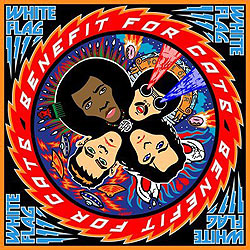
Recently we’ve been treated to new music from the venerable White Flag, an excellent EP called Keepers Of The Purple Twilight. Released on Target Earth in March of this year, all five songs are fantastic, featuring the White Flag hallmarks of clever, witty lyrics, which are often belied by hooky, but rocking tuneage.
One intriguing factor is that lyrically, the tunes are pretty introspective, perhaps pondering where a band like White Flag, who has been consistently making music but continually underrated over the years, fits into this weird world of American Idols and Justin Biebers.
If you haven’t been paying attention to White Flag, we’re here to help fill in those gaps for you. What follows is a conversation with singer, guitarist, songwriter, and main Flag-waver Pat Fear about the history of the band, including just a few of the “28 years of stories” he’s accumulated about punk rock, playing Greenland, The Shaggs, Os Mutantes, Gasatanka Records, and being the most connected band in the universe.
Popshifter: White Flag started in 1982, is that correct?
Pat Fear: Have you been reading the bio or something? (laughs) Just kidding! It actually started (laughs) about a mile from where I grew up. Our first gig was at a high school graduation party.
Popshifter: What inspired you to start the band? Was it a response to the uber seriousness of the punk movement?
Pat Fear: It was. I’d been immersed in punk rock since 1976, but the people that started in the band with me were not—in fact they were diametrically opposed to it—but we all had the same smart alecky sense of humor. The band was formed for two reasons: one, because I was very frustrated with the punk rock scene in L.A.; it had started out with very sensible, cool people and ended being the exact opposite, with these morons who just wanted to go to shows and basically fight. It was a reaction to the ethics and etiquette that were missing.
I’m not from Hollywood; I’m from Sunnymead, California, which is now known as the thriving metropolis of Moreno Valley. Back then it wasn’t even a city; it was just an area called Sunnymead.
We had no public transportation, no stoplights, no supermarkets. It was a farm town. The only reason people lived there was because they were wheat farm or orange grove owners or their parents were stationed at the Air Force Base. It was pretty much exactly like the movie Over The Edge, except less sophisticated.
Popshifter: So how did you hear punk being so far away from L.A.?
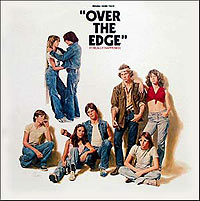
Pat Fear: It’s a very odd story. Are you familiar with Dr. Demento?
Popshifter: Yeah!
Pat Fear: I didn’t know it at the time, but Dr. Demento was syndicated and his shows were broadcast all over the world, apparently. But where we lived, he was live and you could call in and talk to him on the air and ask questions. It was like a religious thing on Sunday nights; you would turn on KMET, which is kind of a progressive rock/heavy metal station out of Los Angeles, and on Sundays most FM stations had really unique programming.
It started with Dr. Demento for four hours and then the Flo & Eddie Show for an hour, which was insanity; then the National Lampoon Radio Hour, which was unbelievable; and then they had a talk show with the manager of KMET that was barely about music, but which was really interesting because all these people would ask these rock questions but he didn’t know anything about that kinda stuff.
It was a really unique experience because from like, 6 p.m. to midnight, I was glued to my radio. Dr. Demento played a crazy, crazy song. I had been corresponding with him: if you’d write him a letter at KMET and he’d get it, he’d read it on the air and answer questions. It was a really interesting and interactive thing. I had no idea people around the country were hearing him! Because we thought he was a local DJ!
He played a song called “Martian March” by the Roto Rooter Good Time Christmas Band. There was no record store where I lived, and there still isn’t as a matter of fact, but the big town of Riverside, which is 15 miles away. . . there was no way to get there when you were a kid—there was no such thing as a bus or subway—so it would be when your parents would go into town. It wasn’t that often because as a military family, all your shopping was done on the air force base or mom and pop fruit stands.
There was one Wherehouse Records in town and I wanted to see if I could find the Roto Rooter Good Time Christmas Band. So I started thumbing through the “R” section in the record store and I pulled out this black and white LP with four people who looked like the smoking section at my high school. They were called The Ramones. I took this record out and turned it over and looked at the song titles and was like, “What?” And then I looked at how long the songs were and was like, “Okay, this has to come home with me.” (laughs)
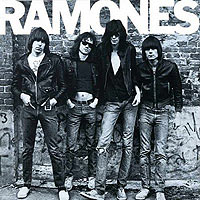
I had no idea what this was and apparently it had just come out; they had one copy in the “R” section. And the guy at the counter looked at me kinda funny and asked, “Do you know what this is?” And I said, “No, but I’m really curious.” He said, “I am, too, but we’ve only got one copy so I couldn’t open it.”
So I took it home and I put it on and “Blitzkrieg Bop” came on and I thought, “Okay, this makes absolutely NO sense.” And then the song’s over, and the next song sounded exactly like the song before it, and now it’s already over. And that was it! I thought, “I need to explore this.” It was like something completely alien.
But I had been exposed to weird music in 1968 when I was a little kid when my sister brought me the first Os Mutantes album as a present for me when she was an exchange student in Rio de Janeiro.
Popshifter: Oh! So that’s where it came from!
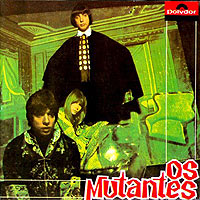
Pat Fear: My sister, who wasn’t even a music fan to any degree, knew that I liked music because I already had Beatles records. And she brought back the only rock record she could find in Brazil not knowing that it was going to start this cavalcade of insanity for the next 40 years. . . which ended up with me in the band’s living room in São Paulo watching them rehearse! It was the most improbable thing in the world, even more improbable than discovering the Ramones!
So that’s how it started. After that, there was a little bookstore at the university in Riverside, that also had Melody Maker, Sounds, and New Music Express and I would buy those and read about all these things. I couldn’t get Creem—the closest we got to music magazines was Super Teen and things like that and Tiger Beat.
I started seeing pictures of the Sex Pistols and the Buzzcocks and I thought, “These people look really weird and they look nothing like The Ramones!” The Ramones literally looked like people I went to high school with; they didn’t look like punks to me, although the Sex Pistols and Generation X looked like they were from outer space.
We ended up getting a Licorice Pizza in Riverside that had a whole section of Punk Rock; it was intermixed with AC/DC and Cheap Trick and the first Tom Petty record because they were considered punk rock. That’s how it started.
Nobody liked it and eventually I had to force people into liking it. Nobody in White Flag liked it AT ALL! But they knew that when I came up with the idea that it would be troublesome for people [This was reason number 2 for starting White Flag.—Ed.]. They were all in a band that played covers of Led Zeppelin. They all pretty much had the same sense of humor, but weren’t quite as adventurous, musically, as I was.
So when I came up with the concept. . . they barely even knew who BLACK Flag was; I mean, this was 1982. But they knew that the idea of being in a punk rock band, performing in front of their normal, backyard, beer-drinking audience, would be funny.
It was basically to cause trouble, but it was a double-edged sword because it was about me being able to cause trouble in the punk rock scene that I was already disillusioned by.
Popshifter: Who were the original members of White Flag? Were they all your neighborhood friends?
Pat Fear: They were all from the neighborhood, people that I went to school with and had known for a long time. The original members were me, Pick Z. Stix—who was the teen heartthrob lead singer of the local cover band, who was really popular, called Tyrant. They would do covers of Thin Lizzy and Judas Priest.
He was a very good vocalist, so we basically put him on drums! (laughs) Which he had never played in his life! And Doug Graves was the bass player in Tyrant and El Fee was the guitarist in Tyrant. And we found the most obnoxious person we knew to be the lead singer, with me taking a page from the Malcolm McLaren Handbook. We got Tyrant’s roadie, Al, who looked like Ozzy Osbourne, had hair down to his butt, and was out of control ANYWAY, to be “Al Bum” the singer.
He had never sung before, and it was perfect. I knew this was the genesis of bands like The Germs, with people who couldn’t play and had no experience. And it worked perfectly. (laughs)
We got the exact reaction we needed at the first two shows we played, which were these backyard parties and the next two gigs we played were opening for Black Flag.

Popshifter: Wow, that is so funny.
Pat Fear: We’re talking about full on platform boots, satin pants—
Popshifter: (laughing)
Pat Fear: —and Al dressed like Ozzy with a fringed shirt and spandex. Black Flag were friends of mine from the old days; I had seen them with Keith Morris. We borrowed all their equipment because we didn’t have any. The guys from Tyrant didn’t and had some but it wasn’t anything like what the guys from Black Flag were using: they had huge amps. Plus, we were lazy.
So we played and these people with shaved heads and Mohawks were like, “What? You’re called WHAT? And you’re doing WHAT? In front of me dressed like that?” These hippies would come out and then there was me, with short hair and a moustache, dressed like a cop, just to further infuriate them. And then we’d play hardcore. Interspersed with Black Sabbath covers. Really slowly.
Popshifter: (laughing) As opposed to really quickly, like The Dickies.
Pat Fear: (laughing) Yeah, exactly! And the singer looking like Ozzy helped. And that’s how Black Flag ended up looking on the back cover of our first album, S Is For Space, cringing in fear from us. Henry [Rollins] used to wear our t-shirts and stuff; they got the joke, you know, they’d seen what happened. Of course, they capitalized on what happened when the scene got really big, but they also understood the sense of humor we had.
Popshifter: You’ve had a lot of different people in the band over the years.
Pat Fear: It’s been a pretty loose knit thing. They’ve even played gigs without me, as hard as that is to believe. One of the best gigs was when I was going to school and had some school commitment, like a final or something. It was a Battle Of The Bands, which we entered just to cause trouble. It was a heavy metal contest for Claremont College, but I was going to UC Riverside. You had to be selected to be in the competition.
I had been hanging around with Blackie Lawless, who was later in W.A.S.P., when they were called Circus Circus. I had their demo tape, which was really good, and I sent that in as our tape and we got selected to be in Battle Of The Bands.
Popshifter: Hahahaha!
Pat Fear: This was probably our fourth or fifth gig and it was a giant event, with maybe a thousand people at it. And I couldn’t make it. We said, “Who cares?” (laughs) They were going to hate it anyway because they were expecting this W.A.S.P. demo, with Blackie Lawless on vocals.
Al Bum wasn’t singing for some reason, so we had El Fee and Doug and Jeff English, who was this other insane person from high school, and some other kid, who was a fan of White Flag, played a second bass. He named himself after an HP Lovecraft character, Yog-Sothoth. Tony Coppinger was just another friend from the neighborhood. He was in a local band that had nothing to do with punk rock, but he had a similar sense of humor.
Jeff English was absolutely, beyond out of control, and he looked just like John Oates from Hall & Oates. Again, another person who had nothing to do with punk rock; he just wanted to cause trouble.
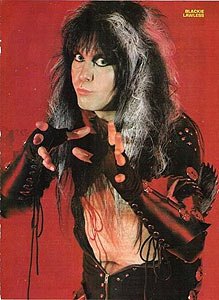
Blackie Lawless
The album was out because Jeff had the S Is For Space album, was throwing it out in the audience, and people were throwing it BACK.
Popshifter: Hahahaha!
Pat Fear: They played one White Flag song, “Mirror Mirror.” The ultraviolence. . . you can’t even imagine how angry the audience was. They were thrown off stage by the Battle Of The Bands people, because they were expecting a heavy metal band. Of course, everyone in White Flag dressed the part, and out came this craziness, which was basically just antagonistic performance art.
And the best thing about it, was that White Flag got third place out of ten bands.
Popshifter: Hahaha!
Pat Fear: But as far as other band members, as people lost interest, they left. I mean, Pick Z. Stix quit after four gigs because he had blisters on his hands. He never intended to be a drummer so he had no stamina. It wasn’t like it was animosity, he was like, “I can’t do this; it hurts too much!” (laughs) So that was the end of him as a drummer.
He left the band for five years and when he came back, he was a guitar player and singer. The other people have rotated in and out; we’ve never broken up. But things have changed.
We had half the Muffs in the band at one point; Greg Hetson and Steve McDonald have played in the band. Ken Stringfellow [from The Posies and Big Star] joined in 1994 and never left.
There was one gig we played in Seattle when we opened for Big Star, when White Flag was Trace Element, me, Ken Stringfellow on bass, and Jon Auer [also from The Posies and Big Star] on guitar. So it was half the Posies but also half of Big Star!
We’ve got people who live in Europe who were fans of the band, who flew us over to play some festivals with them, like this band from Sweden called Sator. They’re not really known here, but they were headlining 50,000 seat arenas and they flew us over to play with them because they liked us. They were fans and they covered one of our songs. A record that went gold in Sweden. That was pretty much a big deal for us: a song that I co-wrote. My name is on a gold record.
Popshifter: That is pretty cool, yes.
Pat Fear: So they ended up being in the band because we would go to Europe, and other people couldn’t go, so we’d pick up one of them on bass or guitar. And they were fans; they considered it a lucky break to be in one of the bands they were fans of!
Everyone’s still in the band; nobody ever leaves. It’s not a full time thing. We’ve been persistent, we just haven’t been consistent. Because we just don’t take it seriously as a career. It’s something to do for fun, an artistic outlet. None of us are ever doing it full time; maybe if we had taken it seriously it would’ve worked out that way, who knows?
But the effort we’ve put into it has been returned exponentially. Like we’ve played Greenland and there aren’t many bands who can say that.
Popshifter: How did that come about?
Pat Fear: We were playing in the Faroe Islands in 2003, of all places, and somebody mentioned a rock festival in Greenland. I said. “Okay, well tell them about us.” So I get home and the people from Greenland contacted me and said, “We want you to headline next summer.” Lo and behold, we did.
That was the weirdest experience of my life, I can tell you that much! We had one fourth of the population of Greenland in the audience. The weather wasn’t very good, which is normal for there, and people were saying that they came six hours by speedboat. There are no roads between settlements; there are only snowmobiles or water routes.
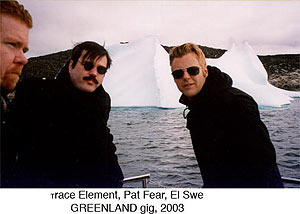
It was insane. The people were wonderful. One of the opening bands was all indigenous people from Greenland, in an all Deep Purple cover band called Peep Durple. It was unbelievable because they were great!
Popshifter: (laughs) That’s insane!
Pat Fear: Think about it, we’re in Greenland! (laughing) It was a two-day festival. On the Friday night, they had a fireworks display, which was probably the single most precariously unwise, dangerous thing I’ve ever experienced in my life.
They were the kind of fireworks you’d see at Disneyland or the Rose Bowl? They were being handled in the most cavalier manner. . . like basically being put into tin cans and lit—
Popshifter: (laughing)
Pat Fear:—and sent up into the sky. Like a crowd of people standing around a barbecue pit and shooting off professional, atom-bomb-sized fireworks. . . it was UNREAL! I’m like, “Okay, guys we need to live through this experience so let’s back away.”
Popshifter: (still laughing)
Pat Fear: It was all timed very specifically. This promoter kept running up to us and going, “We’re going to firework!” So he’s dragging us outside from where we were backstage and I didn’t know what that meant.
And I walked outside and it looked like a cartoon rendition of what fireworks look like, and I’m like, “What is this? Is this some kind of art thing?” And they lit the fuses and they blew up in the sky! No fire department. . . when you see these things here, there will be huge barriers. . . people were smoking cigarettes and drunk out of their minds.
Never mind being at a punk rock riot after a Ramones gig; this was dangerous!
Popshifter: How did you decide to start Gastatanka Records?
Pat Fear: Nobody was going to sign us at that point. El Fee’s sister was dating a guy who had a lot of money. He lived in Denver, CO. His sister was quite a bit older and but we knew her. So this guy was going to put out a record for Tyrant and I thought, “I could probably get this guy to put out a White Flag record.” I convinced him that putting out a record for us would make a bigger impact. He wanted to impress his girlfriend and since El Fee was in both White Flag AND Tyrant, I kind of cajoled him saying I knew all these people in the music business and I could get the records into stores.
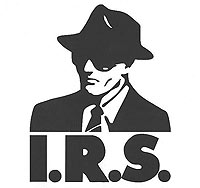
Which I did! I got Miles Copeland from IRS Records to distribute it. So this guy financed it. He actually financed the first record—R Is For Rocket—by accident. We had sent him a crappy demo tape of that and he knew nothing about making records. He ended up making that into the record without our permission. The communication was so poor because we’d never done it either.
He sent us back records and we explained to him that it sounded terrible! In retrospect it was cool, but then it was not what we wanted. He said, “I can’t put you into a recording studio because I spent all this money pressing it.” I said, “Well, we’ll record it on our own.”
I had a four track reel-to-reel and we had Don Bolles’ [The Germs] drum set, the mixing board from the Masque [punk club in Hollywood started by Brendan Mullen]. We made a better version of the album and that’s what ended up going on the record.
We destroyed the first record. The guy kinda felt bad about what happened and agreed to still press the record. We made tons of money off the album when it came out because it sold! It sold out. It was gone like a week after I gave it to the distributor. This was Faulty Products, the distribution arm of IRS Records. They were calling us up and saying, “We need more,” and I was like, “Uh, there are no more.” And they said, “There better be. . . in a week!” So I had to talk the guy into pressing more.
The best part about the whole story is that it was pressed—and this was unbeknownst to us because we didn’t know the first record [from the demo tape] was going to be pressed at all—at a place that specialized in homemade Christian records. The kind you see in thrift stores, like His Royal Rangers Sing Gospel Hits.
Popshifter: (laughing)
Pat Fear: We had taken on an anti-drug, pro-Reagan, anti-communist Christian stance as our faux image. Because it made no sense. We had a song called “Go To God” on the album, which was a joke about giving up drugs and punk rock and going to God, but it was a hardcore song.
So anyway this company that pressed it saw that song listed on the cover and said, “Let’s put some of this in our store” and distributed it to other Christian, Mom and Pop stores. That first record was only distributed through Christian book and record stores in out of the way places.
Popshifter: (laughs)
Pat Fear: Because we destroyed the rest of them! We pressed 500 and we got like, 478 back, so there were like, 22 copies out in the world that may still be sitting on the shelves of some Christian store.
I found one person who said they had it and I didn’t believe them but they gave me the appropriate track listing. This was pre-Internet. Someone in Europe wrote me and said, “I’ve got your record” and I wrote back saying, “I don’t believe you.” And they gave me the track listing in the right order.
Popshifter: How did it even get over there?
Pat Fear: I don’t know, I don’t know! And he never wrote back when I asked him! It was someone from Slovakia? Or back then, it must have been Czechoslovakia. That’s the world of those underground collectors, especially in Communist countries.
I found out years later after playing Croatia, that was the way things worked. Things were smuggled, things were copied on tapes. One guy said they would put a cassette with no case and the J-card from a professional cassette and put on extra large shoes and put the tapes in the bottoms of their shoes. They said their feet were never searched. That was pretty eye opening.
You know we’re only up to year three of the band’s existence!
Popshifter: (laughs) You had said earlier about your sister bringing Os Mutantes to you. . .
Pat Fear: Which was a complete mind blower, let me tell you!
Popshifter: I didn’t know about Os Mutantes until I got the Tater Totz albums [a collection of members of White Flag, Redd Kross, plus Pat Smear, Michael Quercio, and others who released albums of off-the-wall covers in the mid-to-late 1980s including some by Os Mutantes].
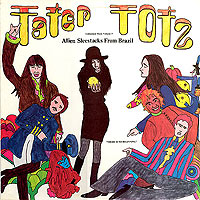
Pat Fear: That’s where 99.9% of all people heard about them first in America. The other one percent heard about them from me, when I gave out cassettes of them, starting from when I was seven years old when I first got the record.
Popshifter: What does it feel like to read things about Beck or David Byrne getting the credit for spreading the word about the band?
Pat Fear: David Byrne infuriates me, but Beck was respectful. He and Kurt [Cobain] were two of the highest profile people in the alternate music universe, and Sonic Youth, too. I still have the postcard Thurston [Moore] wrote me when I gave him the Os Mutantes tape. “I cannot believe this tape!” And Sean Lennon was like, “Oh my god, this is insane!”
And then Sean ended up playing with Arnaldo [Baptista, one of the original Os Mutantes members] and doing the cover for the Tecnicolor album [originally recorded in 1971, but not released until 2000].
As long as the band got press and got popular. . . the new Os Mutantes record is dedicated to me, so I think I’ve been vindicated.
Popshifter: Aw, that’s really nice.
Pat Fear: Even more frightening, is when they were getting back together, Sérgio [Dias, another original member] asked me if I wanted to be in the band.
Popshifter: (laughing) “Even more frightening!”
Pat Fear: I said, “No, I can’t handle that responsibility.” And it wouldn’t be authentic, if you can’t get Liminha, the bass player back and Arnaldo on keyboards, you need to get somebody from Brazil. It can’t be me in there.
It was a very hard thing to do, but I think it gives me a little bit more credibility.
Popshifter: (laughs)
Pat Fear: Being in Os Mutantes. . . it would’ve been a long commute for me, personally.
Popshifter: (laughing) Yeah!
Pat Fear: But I did get to play with them on stage for “Bat Macumba” [from their self-titled debut and later covered by Tater Totz on Alien Sleestaks From Brazil in 1987] right around my birthday last year which was a big thrill.
I wrote songs with them, none that they actually recorded. . . although that’s not true.
You’re going to be the first one to break this—
Popshifter: Ooh!
Pat Fear: —and I’m probably going to regret it because I’m going to be badgered for the rest of my life. . .
Popshifter: (laughs)
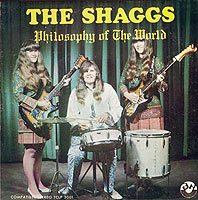
Pat Fear: When I went to New York in 1999 to see the Shaggs when they played with NRBQ at their 30th Anniversary concert, I ended up getting to know them. They didn’t understand that they were going to be mobbed and I ended up being their handler. They had never experienced anything like being mobbed for autographs, so I set them up with a table for merch and stuff and ended up being their manager for a day. So I got to know them pretty well over the course of the two days.
They were really nice. It was only two of them; Helen wasn’t well enough to play [The Shaggs were comprised of three sisters: Dot, Betty, and Helen Wiggin; Helen died in 2006] so it was just Betty and Dot. That was the first time they had played since they broke up in 1975. I went to the soundcheck because I was not going to miss one second of Shaggs performances!
I met them and they were just standing around, these two, nice, older women—normal people who looked like middle-aged housewives—but they had guitars with them. And I barely recognized them. I said, “Look I don’t want to bother you but I came from California to see you. This is a big thrill and I’ve always liked your music.”
And they were like (adopts Shaggs-like accent), “Oh, that’s so nice!” They talk just like they do on the records. I was like, “Wow, this is actually happening.”
Dorothy [Dot] had a PeeChee folder in her hands and she opened it up right before they were about to do the sound check and she said (in Shaggs voice), “Oh, we’re only gonna do four numbers because we didn’t have time to study them.” And she opened this PeeChee folder and there was handwritten sheet music to “My Pal Foot Foot.”
Popshifter: Oh my goodness.
Pat Fear: Those songs were written out and scored on sheet music, by hand! And when she said “study” she meant, study the sheet music.
Popshifter: How is that even possible? (laughs)
Pat Fear: Jaw on the floor! I was with Howie Pyro [D Generation] and we were both like, “Oh. My. God. You don’t know how much I want that piece of paper.”
Popshifter: Hahahaha!
Pat Fear: So I ended up keeping in touch with them. We would chat on the phone, but I didn’t want to be a crazy fan and stalk them or anything like that.
So later on, I got asked to coordinate this musical project—oh man, I’m really getting in over my head with story; this is gonna haunt me—for a Spanish cartoon show called Motel Spaghetti.
When I was on tour with White Flag one of the show’s creators was like, “Hey, can you write a song for us?” And I said, “Yeah, what’s it for?” He said, “Well, we’re doing this TV show and we want a song in every episode like The Monkees. And he said, “Do you know anyone else who can help do this?” and I said, “Yeah, I do, as a matter of fact.”
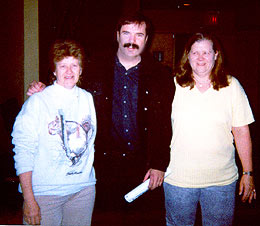
Pat Fear with The Shaggs
I wrote our song in Spanish and sent it to them and they really liked it. They said they wanted to do a soundtrack album, too. I saw the cartoon and it was really well done; it was really funny. I said, “How about this? I’ll get some of my other musician friends to do music and I’ll write the songs so that they’re thematically the same. Why don’t we do a song about each character?”
And the producers were like, “Great!” So I wrote all these lyrics, one song about each crazy character, and I got NOFX, Sean Lennon, Redd Kross, Eric Erlandson [Hole] did a song with Anna Waronker [that dog, Ze Malibu Kids]. . . they all did songs for this compilation.
And I was in touch with Sérgio [Dias from Os Mutantes] and they were not together at that point. And I asked him, “If I write this song, will you do it?” And he said, “Oh sure, I’ve got a studio.”
And I had this stroke of genius. I called up Dorothy Wiggin and I said, “I have this project. Do you wanna help me write the lyrics to this song for a TV show?” She said (in Shaggs voice), “Oh, I haven’t written a song since we broke up.”
I said, “Well, I’ll give you the topic and write part of it,” and she said, “Okay, well send it to me.” So she finished the lyrics, and I gave them to Sergio, and he recorded it.
Popshifter: Oh my god.
Pat Fear: So I combined The Shaggs, me, and Os Mutantes on a recording.
Popshifter: Amazing!
Pat Fear: And it’s never come out because the people that made the cartoon show had meetings with the Cartoon Network and MTV and both wanted it, but they wanted to take control of it and the creators said no, they wanted script control and creative control, and it never went anywhere. So I have an entire compilation record of songs about cartoon characters that nobody’s ever heard of.
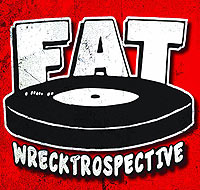
NOFX released their song as part of their Singles Club and it came out about a month ago. It was on this three-disc release called Fat Wrecktrospective. It’s called “Spaghetti Motel,” oddly enough. Sean Lennon actually wrote his own lyrics to his song, but I’m the only person to ever co-write a song with NOFX that isn’t in the band. So that’s kind of funny.
So I got The Shaggs, Os Mutantes, and me, melded into music that no one will ever hear. (laughs)
Popshifter: That’s really a shame.
Pat Fear: Well. . . I was thinking that even without the cartoon the songs are really good. The Shonen Knife tribute I put out [Every Band Has A Shonen Knife Who Loves Them, 1989] before anyone even knew who they were. . . that didn’t make any sense and it was still a good record.
Popshifter: Yeah, that’s true!

Pat Fear: But yeah, Gasatanka started because no one wanted to sign White Flag and we knew a guy who had money. And my friend Bryan who was one of the few people who got into punk rock with me in high school—he was in my first punk rock band Death Patrol; we never made any records or anything although we’re on some compilation tapes—he came up with the idea.
His father had a farm, which most people out in Sunnymead did, and his farm had a diesel pump for the tractors. It was a pump house but it looked like a regular, old-fashioned ’50s gas station. We used to practice in the barn in his farm and Brian was putting gas in one of the generators that powered the barn and he held up the gas pump and said, “This looks like the Casablanca record label logo; we should start a label called Gasatanka.”
Popshifter: Oh my god, really?!
Pat Fear: And that was before White Flag existed! That was how Gasatanka was born, because the way he was standing holding it looked like the original Casablanca logo. It had a Humphrey Bogart-esque person down in the corner.
Popshifter: I figured that it was a reference to Casablanca, but I didn’t know that story.
Pat Fear: Well, you know, it’s never been told!
Popshifter: That’s hilarious!
Pat Fear: You’re getting a lot of exclusives here!
Popshifter: Hahaha!
Pat Fear: And please print, “Do not bother me for any Shaggs/Os Mutantes songs: I’m not giving them to you!”
Popshifter: Hahahaha! I will, I am writing it down now!
Pat Fear: All the songs are named after characters but I can’t remember the name of that one. Better to leave it a mystery.
Popshifter: That’s fine.
Pat Fear: I want it to become a nugget in the pantheon of rock legends. It’ll be like The Beach Boys’ Smile.
Popshifter: Hahaha! Based on this discussion, White Flag has a lot of connections to other people.
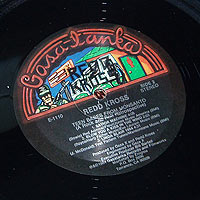
Pat Fear: Well, if you go to band2band.com, we’re it! It is hilarious. First of all, I need to give proper credit to that website. The person who does that website is out of his mind.
Popshifter: (laughs)
Pat Fear: Can you imagine the work that goes into that?
Popshifter: I had tried to think about all the connections between Redd Kross and other bands and it was just so impossible.
Pat Fear: He must have no life or a lot of assistance.
Popshifter: It’s a pretty cool site.
Pat Fear: It’s unbelievable! Never mind the fact that I’m at the center of its universe!
Popshifter: It just proves what people have been saying, that you wouldn’t believe all the connections White Flag has in music. But now, there’s proof!
Many thanks to Pat Fear for being so generous with his time and answering all these questions!
2 Responses to “It’s White Flag’s World, We Just Live In It: An Interview With Pat Fear”
October 16th, 2013 at 2:13 am
Thank you so very much for the wonderful interview of my brother. I miss him so much, there was so much of his life I was not able to share with him, i have always been so grateful that the Os Muntantes record made it back from Brasil (Brazil) with me so many years ago (actually in summer of 1969, not 1968). He was in love with music at such a young age mainly the Beatles, up until that time. He was a brilliant, giving and compassionate man, as well as talented and loved by so many. i can only continue to say that my brother truly added to the the landscape of music in very innovated way for many decades. We just had a relatively small life celebration for him at Howie Pyros’ cafe in LA on Sunday 10/13/13. It was a difficult but heart warming event to hear so many share such wonderful emotions and stories about my little brother. It was great to have representatives from all areas of the music industry present as well as some members of bands in adition to White Flag, such as The Germs, The Melvins, Sonic Turtles, Go Goes, Holes etc. I can not remember everything because it is all still very raw and and rewarding as it was to feel the love in the room from people that came as far away as Italy, and to see so many grown men cry I wish we could have had him here a bit longer. I know where ever he is now it is brighter place than it was before, and he continues to bring joy with his music, wit. I love you Bill, you will always be more than Pat Fear, you will forever be my incredibly intelligent little brother who loved music, chess and Bonbon…wish our lives had not ben so busy I miss you so much, your Sis.
October 16th, 2013 at 9:52 am
Thank you so much for commenting on this article and sharing your feelings. I am touched and honored.
I wish you and your family love and strength in dealing with this terrible loss.
LLM
Time limit is exhausted. Please reload the CAPTCHA.